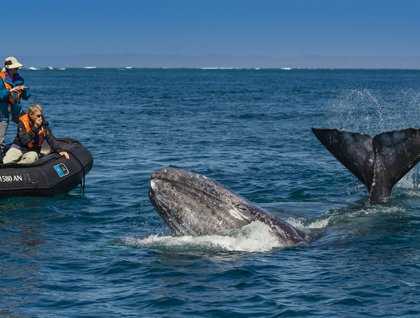No words can describe what we witnessed today. And images alone can not portray the excitement we felt. It’s April 1st, but his is not an April Fool’s joke—today we were touching whales, and they were touching us.
Imagine a 35-foot long, 30-ton whale rubbing up against the bottom of your 17-foot inflatable boat. Add a 20-foot long, 5-ton baby lifting its eye above the water to get a look at you, then approaching your boat wanting to make contact, and you have an overwhelming situation that fills all your senses and sparks your emotions.
San Ignacio Lagoon is a World Heritage site and part of the El Vizcaino Biosphere Reserve, one of the largest protected areas in all of Mexico. Each winter, California gray whales come here to mate and give birth to their young, making the almost 6,000 mile migration from their feeding grounds in the High Arctic in Alaska to the warm shallow, and protected calving lagoons along the west coast of the Baja California Peninsula. Their migration is one of the longest of any marine mammal on earth.
It is the whales that choose to make contact, pushing on our boats, coming to the surface, and looking into our eyes. We can only imagine what they are thinking.
The mother whale pushes from below lifting her calf partially above the water. The calf rolls off mom and then swims closer. In unison we touch the whale’s rubbery skin. To me, the mottled skin feels like a wet eggplant, soft and slightly spongy.
It’s an emotional feeling, touching a whale. They have forgiven us for the horrendous slaughter that took place in these lagoons over 80 years ago, during the whaling days that drove this amazing animal to the brink of extinction.
We are humbled by what we experienced today. Looking into the eye of a whale can change you forever. On my first trip to Baja 26 years ago on the M.S. Polaris we came to this same lagoon. I touched a while then and it changed my life forever. I’ve been coming back every year since that fateful day. And, with luck, I’ll be back again next year







